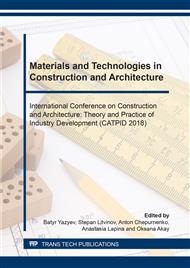p.891
p.897
p.901
p.905
p.910
p.914
p.920
p.926
p.933
Assessment of Heat Saving from Intermittent Heating of Buildings with Different Thermal Stability
Abstract:
Modern buildings are characterized by a high resistance to the heat transfer of the outdoor enclosing structures, a high density of translucent structures, which put the intermittent room heating in the conditions when the formerly made surveys of the past years are not sufficient. The heat resistance of the building enclosing structures reduces the savings in the intermittent heat supply for heating needs, as it requires an intensive heating before the start of the working days. The more the power of a heating system is and the shorter the heating time is, the more economical the operation mode of this system is. The less the internal heat resistance of the room is, the greater the heat economy is. The thermal savings are bigger, if the room cools quicker after reduction of the heat supply.
Info:
Periodical:
Pages:
910-913
Citation:
Online since:
September 2018
Authors:
Price:
Сopyright:
© 2018 Trans Tech Publications Ltd. All Rights Reserved
Share:
Citation:


